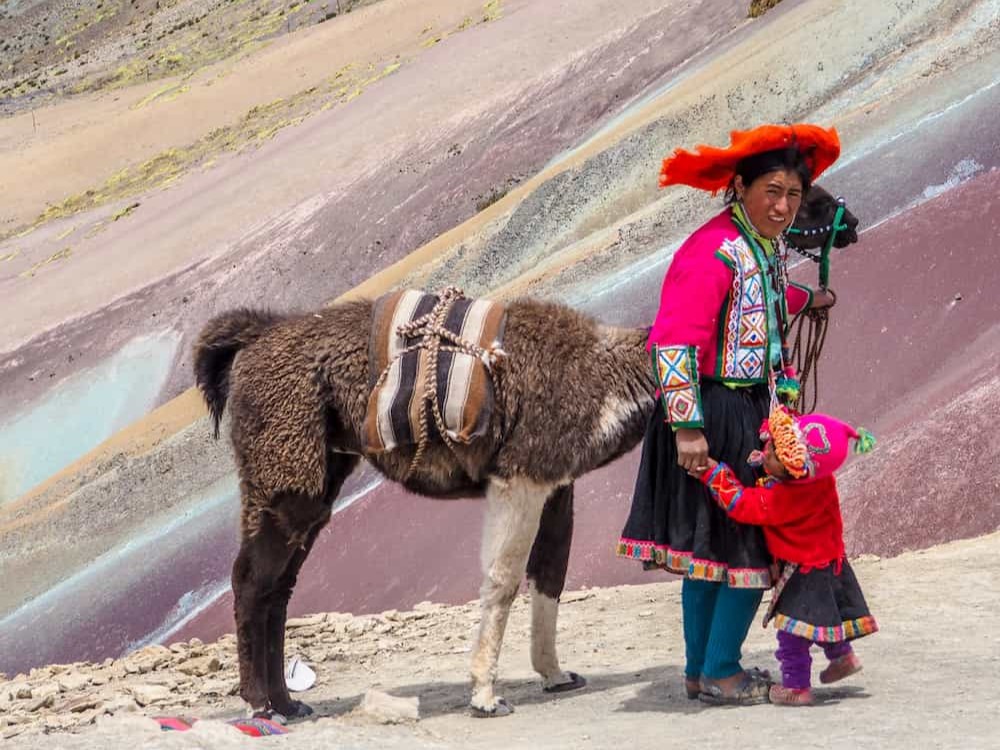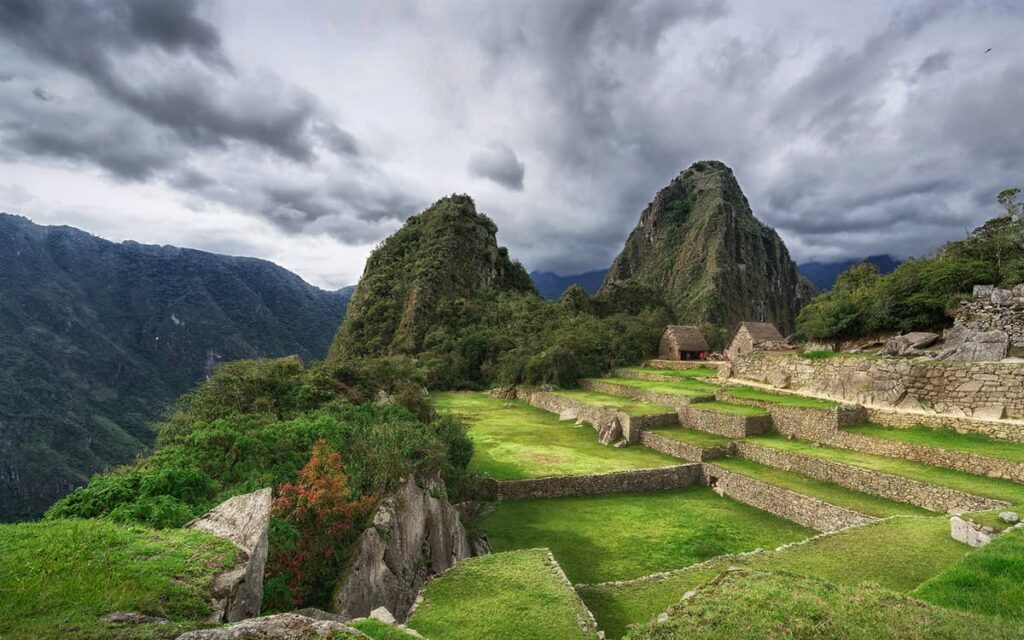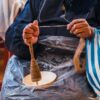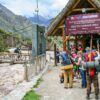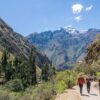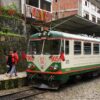This temple is quite famous among the people of Lima for the large number of relics on its altars. It is an important center of spirituality to which dozens of people make daily pilgrimages in search of a space for reflection and enrichment of their faith.
The Basilica and Convent of San Pedro in Lima began to be built in 1568 at the initiative of the Society of Jesus. At first it was called Colegio Máximo de San Pablo and it was the headquarters of the Order. Over time, reforms were made that led to three different versions of the temple.
The spacious three-nave building that exists today was built between 1634 and 1636. It is the result of a skillful adaptation of the plans for the Church of the Gesú in Rome. Its format corresponds to the one adopted at that time by other parishes in Lima. Unlike traditional Roman churches that consist of a large nave and closed side chapels, in this one the central area is narrow and the side chapels communicate with each other by means of arches. The adjacent naves serve for the displacement of processional processions or other liturgical ceremonies.
History
The Basilica and Convent of San Pedro in Lima, built by the Society of Jesus from the 16th century, is one of the most important religious complexes in the Historic Center of Lima, located at the intersections of Azángaro and Ucayali streets. The enclosure is under the tutelage of the Jesuit religious order.
Initially, the Church of San Pedro was attended by the Spaniards who were living in the city and dozens of Indians who congregated in its large earthen atrium. The first temple was so modest that the neighbors had to bring canvases and altarpieces to embellish its walls, silks for the ornaments and pieces of silver for the sacristy. The objective was that the Blessed Sacrament could be exposed with decency (it was understood that the luxurious surroundings pleased God because it allowed to get an idea of ??the divine magnificence).
In 1638, with the assistance of the Viceroy Count of Chinchón and 160 Jesuit religious, Bishop Villareal blessed the main bell of the temple baptizing it with the name of Agustina. This bell is the popular «Abuelita», the oldest in Peru and is said to have tolled at the funerals of Santa Rosa de Lima and San Martín de Porres.
In times of conflict, on the other hand, this religious building was an important landmark. The Society of Jesus, which had been expelled from America in 1772 by order of the King of Spain and returned in 1871, decisively collaborated in the War of the Pacific. Proof of this is that Mariscal Cáceres was disguised as a priest and hidden in this church when he was persecuted by the Chileans. In addition, in the place where the lobby currently stands, the University that became a hospital during the war with Chile worked.
The Church of San Pedro, was by tradition until a few decades ago the temple of the Lima aristocracy. It was built by the Jesuits under the name of San Pablo, and its third version, the current one, was inaugurated in 1638. When the Jesuits first arrived in Peru in 1568, they were housed by members of the Dominican order, later settling in the same year 1568 on the sites where the religious complex currently exists, beginning its construction this year of 1568 on a plot of 150 feet long by 30 wide, its construction was initially simple, with very popular religious services. The Spaniards who were living in the city and dozens of Indians who congregated in its large earthen atrium attended. His first temple was so modest that the neighbors had to bring canvases, altarpieces, to embellish its walls, silks for ornaments and pieces of silver for the sacristy; in such a way that the Blessed Sacrament could be exposed with decency.
The current Church of San Pedro is the product of the importance that Lima was acquiring as a metropolis of Nueva Castilla and because the Jesuits longed for a jewel that was worthy of the order. They took as a model the plan of the Temple of Gesù in Rome. In the atrium was the old cemetery, proof of this is that there is a cross in the place; later this atrium would also serve as a theater. It became more beautiful in the course of time.
The Church of San Pedro was consecrated in 1638 with the assistance of the Viceroy Count of Chinchón and 160 Jesuit religious; Bishop Villareal blessed his main bell baptizing it with the name of Agustina. This bell is the popular «Abuelita», the oldest in Peru and is said to have doubled at the burial of Santa Rosa de Lima and San Martín de Porres. Another very notorious bell is the «Grande» which weighs 100 quintals, for this reason the tower where it is located was finished after having been raised. It is very loud and the second in size after the «Cantabria» of the Cathedral of Lima. The earthquakes that Lima has suffered so far have little damaged the church, which is massive. In San Pedro, who was previously named San Pablo, the Jesuit Francisco del Castillo delivered the Sermon of the Three Hours for the first time in the world, in 1655 because that is how the commentary on the seven words of Christ on the Cross lasted.
The temple
It is not difficult to be dazzled by the majestic facade of this church. It is carved in stone, has three doors and three windows that serve both proportion and clarity. It has two towers and one of them has seven bells.
Of the three doors, the main one is normally open, the other two are usually opened at Easter or other circumstances of religious importance. The doors have stone frames and in the center is the coat of arms of the order. At the top, there is a niche with the image of San Pedro.
Inside the temple is approximately 67 meters long and 35 meters wide and has 10 chapels. Of these, there are five per band that communicate through beautiful arches and generate a kind of additional nave on each side. The altars are gilded, with the exception of the one of San Ignacio and the one of the Relics, both intact of wood.
Without understanding too much of architecture, many styles are mixed in this temple: Baroque, Renaissance and the one known in this city, Churrigueresque.
One of the chapels that stands out is that of the Penitentiary, which with its three harmoniously designed naves, stands on the foundations of what was the second church. You have access through the front door, of course, but historically your entrance was through the gate. This church was destined, precisely, to exercises of Penance. Generally, only males were allowed in. There the various congregations established in San Pedro held their meetings, such as the famous School of Christ of Father Alonso Messio Bedoya, the congregation of students of the faculty and that of the young men, merchants and crafts officers.
Another chapel to mention is that of the «O». The Marian Congregation of Our Lady of the Expectation of Childbirth, known as Our Lady of the O, originally had its meetings in the second Church. Over the years, with Father Juan de Córdova being the director of this group, the parishioners who gathered decided to build their own chapel.
As for the Altar of Relics, you really don’t realize the importance of the place until you really pay attention to what is there. Everything is hidden in drawers but many people come to pray in front of them.
Relics
According to the Peruvian historian Rubén Vargas Ugarte in his work Los Jesuitas y el arte, Lima, 1963, and from the information given in the 1907 booklet the Basilica and Convent of San Pedro in Lima has the following relics:
- Two Lignum Crucis (remains of the Cross of Calvary).
- An ivory Christ, gifted by Pope Saint Pius V to Don Juan of Austria, who held it in his hands at the Battle of Lepanto.
- A thorn of the Crown of Our Lord Jesus Christ given by Father Francisco de Toledo, later a cardinal to the Attorney, Baltazar Piñas.
- A bone from the quill of the Apostle Saint Paul and a ring of the chain with which he was tied in prison, had belonged to the Private Chapel of the Pope.
- A bone from the head of the Apostle Saint Matthew and another from Saint Jerome, sent by Father Hernando Solier S.J. that belonged to the Private Chapel of the Pope.
- Relics of the Apostles Saint Simon and Saint Matthias. In addition to Saint John Chrysostom, Saint Ambrose, Saint Ignatius of Antioch, Saint Lawrence and Pope Callisto, all Martyrs.
- A letter from Saint Ignatius of Loyola and some dust from his body.
- A rib from San Francisco de Borja.
- A silver reliquary, a small bone and a grindstone of Saint Louis Gonzaga.
- Remains of San Carlos Borromeo.
- An artejo from San Juan de Ávila.
- A rib from Brother San Alonso Rodríguez.
- Complete bodies of 41 Holy Martyrs extracted from the catacombs of Santa Priscilla, San Calixto and others in Rome, these are: San Cousin Victor, San Segundo Victor, San Tercio Victor, San Germanico (martyr), San Lucio (martyr), San Vidal , Santa Cristina, San Mercurio (martyr), San Víctor (martyr), San Benigno (martyr), Santa Septimia, San Marcelino, San Amando (martyr), San Félix, San Victoriano, San Corpiano, San Graciano (martyr), Santa Victoria (martyr), San Gaudencio (martyr), San Severino (martyr), San Crecencio, San Electo, San Justo, San Tito, Santa Exuperancia, San Hipólito (martyr), San Celio (martyr), San Urso (martyr), San Flonorato, San Calistrato, San Estacteo, San Eragrio, San Priaciano, Santa Candida (martyr), San Herculano (martyr), San Venerando, San Jacinto (martyr), Santa Aretuza, San Teodoro, San Antonino, San Liberato.
- The almost complete body of Saint Aurelius (martyr).
- Some bones of San Fortunato (martyr), among other Holy Martyrs.
- Some bone of Santo Toribio de Mogrovejo, Santa Rosa de Lima and San Francisco Solano.
On the other hand, the church of San Pedro has been declared an Archdiocesan Sanctuary of the Sacred Heart of Jesus. Since 1878 the Procession of the Sacred Heart of Jesus has been held on the last Sunday of each June. The activity is part of the celebration of the month of the Heart of Jesus that takes place in the parish.
If you travel to Perú, we also recommend you to visit another impressive destinations in the city of Cusco like the tour to rainbow mountain peru or the humantay lake tour from cusco, which only takes one day. But if you are gonna to stay more days in Cusco, other archaeological places you can know will be the choquequirao trek peru, the salkantay trek to machu picchu, and the classic inca trail 4 days 3 nights.

